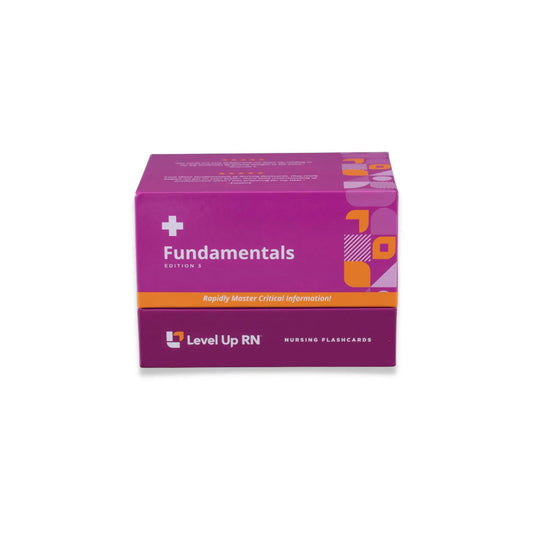Fundamentals of Nursing - Flashcards
This article focuses on pressure injuries, their causes and how to stage them. You can follow along with our Fundamentals of Nursing flashcards, which are intended to help RN and PN nursing students study for nursing school exams, including the ATI, HESI, and NCLEX.
If you want more in-depth information on pressure injuries, check out our Wound Care Flashcards for Nurses.
What is a pressure injury?
A pressure injury is damage to the skin and underlying tissue due to prolonged or intense pressure to that area. Pressure injuries can lead to inadequate perfusion (the exchange of oxygen and carbon dioxide between red blood cells and the body's tissues) and/or oxygenation and cell death.
Risk factors for pressure injuries
Among the biggest risk factors for pressure injuries is immobility. Patients who must remain immobile for a period of time or who must wear a medical device that puts constant pressure somewhere on their body are at risk for a pressure injury. For example, a patient using a nasal cannula might have a pressure injury under their nose or behind their ears.
Other risk factors for pressure injuries include older age, incontinence, poor nutrition, perfusion issues, diabetes, smoking, and the use of corticosteroids.
Braden scale score
A patient whose Braden scale score is less than or equal to 18 is also at risk for developing a pressure injury. The Braden scale assesses six risk factors related to the development of pressure injuries: sensory perception (the ability to respond meaningfully to pressure-related discomfort), moisture, activity, mobility, nutrition, and friction and shear. It is important to assess a patient's Braden scale score at least once per shift.
Pressure injury prevention
There are a number of preventative measures that may be taken to reduce the risk of pressure injuries.
Pressure-redistribution bed and mattress
Place at-risk patients on a bed that provides pressure redistribution, which works through the use of a special type of mattress that uses a combination of foam and air. Another tactic is to set the angle of the head of the bed at less than or equal to 30 degrees. This is because the more upright a patient sits, the more shearing force is placed on their sacrum and other parts of their body.
Repositioning
Reposition the patient every two hours to help redistribute pressure.
Waffle seat cushion
Utilize a waffle seat cushion for a patient who is chair-sitting or in a wheelchair. These cushions help to redistribute pressure. Advise the patient to shift their weight every 15 minutes as they sit.
Heel elevation
For a patient in bed, elevate their feet up off the bed so their heels dangle freely. This can be done with pillows or heel-elevation boots.
Padded dressings over bony prominences
Depending on how the patient is most frequently positioned, pad their bony prominences. This could mean padding the sacrum, the greater trochanter (the big bump on the femur right below the hip), or their scapula or shoulder.
Adequate nutrition
Ensure the patient receives adequate nutrition, especially protein. This will help to maintain the strength of their skin integrity as well as to help to repair any existing tissue damage.
Staging Pressure injuries
Pressure injuries progress in seriousness from stage 1 to stage 4. There are two additional, related wound categories, “unstageable” and “deep tissue injury.” Understanding these stages is an important aspect of nurse training, as prospective nurses will often be asked during their examinations to stage a pressure injury, either by using pictures or by describing the features of a particular stage.
Stage I: Damage limited to epidermis
A stage one pressure injury is damage that is limited to the epidermis (skin). This damage will appear non-blanchable. Blanchability, or blanching is when, if pressed upon with a finger, the skin will briefly turn white and then return to its normal color. In stage one pressure injuries, the skin will not blanch when pressed upon. Additionally, the skin will appear intact (there is no actual, visible wound) and will display erythema (redness).
Stage II: Damage into dermis
In stage two, there is damage to the epidermis and dermis. Again, the skin will display non-blanchable erythema, but now with the addition of a shallow erosion. For example, the skin will have a scrape or an open blister. This is not a deep wound, but the surface of the skin has been eroded through the epidermis into the dermis, usually indicated by a red, moist wound base.
Stage III: Damage into subcutaneous tissue
Stage three is where more serious damage has occurred. This is an open wound, where the adipose (fatty) tissue is visible. Adipose tissue has a yellow, chicken fat appearance. In a stage three wound, the underlying structures are not visible, that is, muscle, tendon, and bone cannot be seen.
Stage IV: Damage extends beyond subcutaneous tissue
Stage four indicates damage that extends beyond the subcutaneous tissue. It is a deep wound, in which another structure may be visible, including muscle, tendon, or bone, or any combination of those — likely in addition to visible adipose tissue. When the underlying structure can be seen, that indicates a stage four wound.
Unstageable: Unknown depth
When the wound bed cannot be seen — if the wound is obscured due the presence of eschar or slough — then it is considered unstageable. Eschar is a type of necrotic tissue, usually brown or black. A slough is more likely to appear tan or yellowish and slimy. No matter what is obscuring the wound base, if it is not possible to determine how deep the wound is, that indicates an unstageable wound.
Deep tissue injury
This is when there is damage at the bone-muscle interface, usually in the form of a bruise. The skin may be intact or non-intact, and it is non-blanchable, with a purple or maroon discoloration.
The differences between a deep tissue injury and a pressure injury are that a bruise is usually caused by an impact of some sort and appears purple or maroon, while a pressure injury is caused by prolonged pressure on an area of the skin and has a red appearance (erythema).


